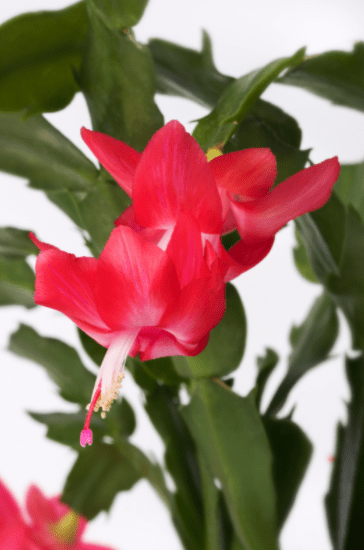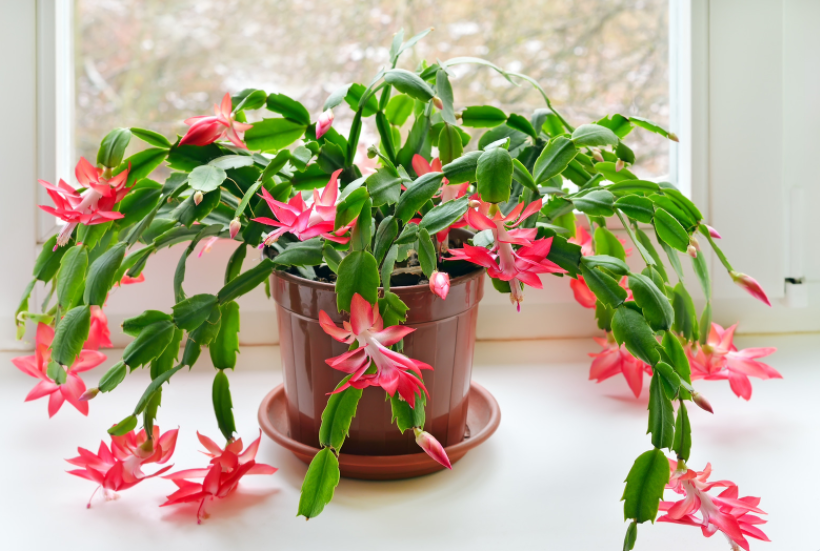Christmas Cactus
The Christmas cactus (Schlumbergera bridgesii) is both a favorite colorful houseplant and a favorite Christmas gift. Because they’re easy to grow, they can live for years.
They’re even more special if they have been passed down through the years from Grandma or Aunt.
Stories abound of 25, 40, or even 50 years old plants. The Christmas cactus is a tropical cactus, so its cultural requirements are different from a desert cactus.
These plants, called epiphytes, grow naturally in the same environments as orchids, often in decayed leaves in the forks of tree limbs.
From the end of their gracefully arching, succulent, flattened leaf segments, pretty blooms of red, pink, white, yellow, salmon, orange, fuchsia, or lilac spring.
Quick Christmas Cacti Growing Tips
To get your Christmas cactus, or your Thanksgiving cactus, to bloom for the holidays, follow these steps:
In September and October, keep your cactus in a place with bright light during the day, darkness at night, and temperatures of 50 to 55 degrees, especially at night.
These are the conditions that trigger flower buds. I keep mine out as long as I can, and it starts buds before I bring it in because of the temperatures.
After you bring it in, put it in a window and enjoy the flowers for several weeks, or even months. Please store it aside from heating vents or drafty spaces. Cooler temperatures will keep the buds blooming longer.
During this time, water your cactus just enough to keep the soil slightly moist, but do not fertilize.
Sometimes buds drop before they bloom. Maybe the room temperature is too warm. Try keeping that room below 70 degrees while the cactus is blooming. Perhaps the humidity is too low. One way to add humidity is to use a humidity tray.
Fill a waterproof saucer or tray with gravel or pebbles partially covered with water. Set your cactus pot on the gravel. Drafts and temperature extremes can also cause flower buds to drop.
Christmas cactus flowers are perfect for air drying because they retain their color. After your cactus stops blooming, treat it like any other cherished houseplant. Water and fertilize regularly.
It’s not unusual for a Christmas cactus to bloom again later in the winter.
After the peril of frost has passed in late spring, move your cactus outside to enjoy the summer.
Place it in the morning sun with some afternoon shade. This is also a good time to prune. You can root segments of the stem in moist vermiculite or potting soil. They should root in about four to six weeks. Enjoy your new plants or give them away.
Repot your cactus when its roots fill the pot. Spring is a good time to repot.
Use a commercially prepared potting mix for succulent plants, or try one of these recipes you mix yourself: two parts plain potting soil with one part clean sand or vermiculite; one part growing soil, two parts peat moss or fertilizer, and one part sharp gravel or perlite; or equal portions of garden loam, leaf mold and pure coarse sand.
How to Start a Holiday Cactus From Seed
Cactus seeds can be harvested from the plant’s pods (fruits). Wait until the pods turn red if they are still green. Typically, the pods transform in the fall. Remove the brownish-black seeds and discard the pulp.
Plant the seeds in moist sphagnum peat moss and vermiculite, loamy compost, or cactus mix. Incorporate the seed directly into the soil or cover it with a thin layer of vermiculite.
To increase the humidity in the growing environment, wrap the pot in clear plastic wrap or enclose it in a clear plastic bag.
Position the plant on a window sill that receives indirect light.
Allow the growing medium to remain moist. You can water the soil surface daily or water the plant safely from the bottom by submerging the pot in a tray of water.
Water should be wicked upwards via the drainage holes. Remove the plant from the water tray once the soil surface is moist.
Seedlings should emerge within two to three weeks. Once you notice seedling growth, remove the plastic.
When the seedlings are substantial enough to deal with, transplant them into individual pots.
Holiday Cactus Potting and Repotting
Holiday cactus prefers to be rootbound and does not require frequent repotting—every three to four years or when the plant begins to look ragged, or roots grow out of the drainage holes.
Frequent repotting can be detrimental to the plant and cause it to stop blooming for an extended period.
Unlike other plants, which should be repotted when new growth appears in the spring, the holiday cactus should be repotted after blooming has ended, and the flowers have wilted in late winter or early spring. Never repot a flowering plant while it is in bloom.
Terra cotta or clay pots are the best containers for cactus plants. These porous pots wick away excess moisture from plants that could be harmed by overwatering. The container should have numerous drainage holes or a single large one at the bottom.
When repotting, choose a container with a diameter of no more than one to two inches larger than the current one. A pot that is larger than that will retain excessive moisture and will attract insects and plant diseases.
Overwintering
Holiday cacti are not frost-hardy and will die if exposed to frost. In USDA hardiness zones 10 to 12, these tropical plants can be left outside (certain parts of California, Florida, Hawaii, and Puerto Rico).
They can withstand nighttime temperatures as low as the 60s, but anything close to freezing will kill the plant.
Take the plant inside before the first frost and keep the soil dry. The cooler temperatures should encourage bud growth. By October, buds should begin to form.
Pests and Plant Diseases That Are Frequently Encountered
Holiday cacti are frequently infested by fungus gnats, flower thrips, aphids, spider mites, and mealybugs. Avoid overwatering your plant; soggy soil is the primary source of attraction for these pests.
In most cases, insecticidal soap and horticultural oil effectively contain an outbreak. The tiny pests can be eliminated by blotting them with an alcohol-soaked cotton ball.
A holiday cactus may not survive a severe infestation and may need to be removed, mainly if other nearby plants.
When plants are overwatered, fungal diseases are common. Prevent fungal infections by avoiding excessive watering.
Fusarium and Phytophthora are two common fungi that can cause stem rot on holiday cactus. Brown spots on the stem at the soil line are caused by Fusarium stem rot. Stem rot caused by Phytophthora appears wet or water-soaked at the soil line.
Phytophthora is a lethal pathogen. A holiday cactus may recover from fusarium if caught early enough, but it is frequently challenging to save.
Let the plant’s soil dry out thoroughly before applying a fungicide according to the package directions.
How to Grow a Holiday Cactus
Plants bloom approximately 18 months after seed sowing under ideal conditions. Each flower should remain open for at least six days, and the plant should bloom for at least four to six weeks.
The flowers are showy and vibrant but have no scent. The best way to keep your holiday cactus blooming throughout the winter is to remove faded flowers or deadhead them.
To ensure that your holiday cactus blooms during the holidays, you may need to force it into dormancy and then coax it out. This is how:
Reduce watering in mid-October (probably once every week or two). Water only when the soil feels dry, approximately an inch beneath the surface. Put an end to fertilizing.
Control a temperature of 50 to 55 degrees Fahrenheit for your holiday cactus and limit the amount of light it receives for approximately six to eight weeks.
The plant can receive indirect light during the day, but it requires 12 to 14 hours of darkness at night. If the room temperature exceeds 55 degrees Fahrenheit, provide an additional couple of hours of darkness each day for your plant.
If the plant receives light at any point during its 12 hours of “night,” cover it with a dark cloth.
Once flower buds appear on the plant, relocate it to a bright window. Ascertain that it is not exposed to any drafts, as the cold may cause it to lose its buds. Within a couple of weeks, flowers should begin to open.
Frequently Asked Questions About Holiday Cactus
Holiday cacti are hardy plants that are temperature and humidity sensitive. They are hardy when kept above freezing temperatures; however, they will require ideal temperatures and conditions for lush flowering during the holidays.
Appearance Impairment or Growth Distortion
If you see that your holiday cactus grows stunted or distorted, carefully inspect it for mealybug infestations. Mealybugs resemble tiny white cotton dots measuring approximately 1/8- to 1/4-inch in length.
They move slowly and frequently first appear low on the leaf surface in dark, warm, moist areas near the cactus’s central stem. The aphids feast on the plant sap and leave behind a sticky honeydew substance that causes mold to show on the plant.
Leaves or stems that are yellowed, spotted, or wilting
If you notice yellowing leaves or stems, leaf spotting, or wilting on your plants, thoroughly inspect them for thrips. Thrips are small black slivers or tiny lobster-like insects.
The damage to the leaves and stems is not directly caused by thrips but by a virus they frequently transmit, impatiens necrotic spot virus.
You may apply insecticidal soap or horticultural oil to control the thrip infestation. If you also remove the plant from its old container and place it in a sterilized container with a new potting mix, it may recover.
Wilting can also occur as a result of insufficient light, insufficient water, or a plant that is too rootbound. Correct those conditions and closely monitor progress.
Turning Red or Pink Leaves
If your holiday cactus’ leaves turn red or pink, it may be receiving too much sun or not enough water. If your plant is in direct sunlight, reposition it in indirect light. If the soil has dried to one inch, it should be watered more frequently.
The general rule is that a holiday cactus should be watered when the top of the soil feels dry.
Follow these instructions and you can enjoy both your old heirloom cactus and the new ones that you propagate.


























